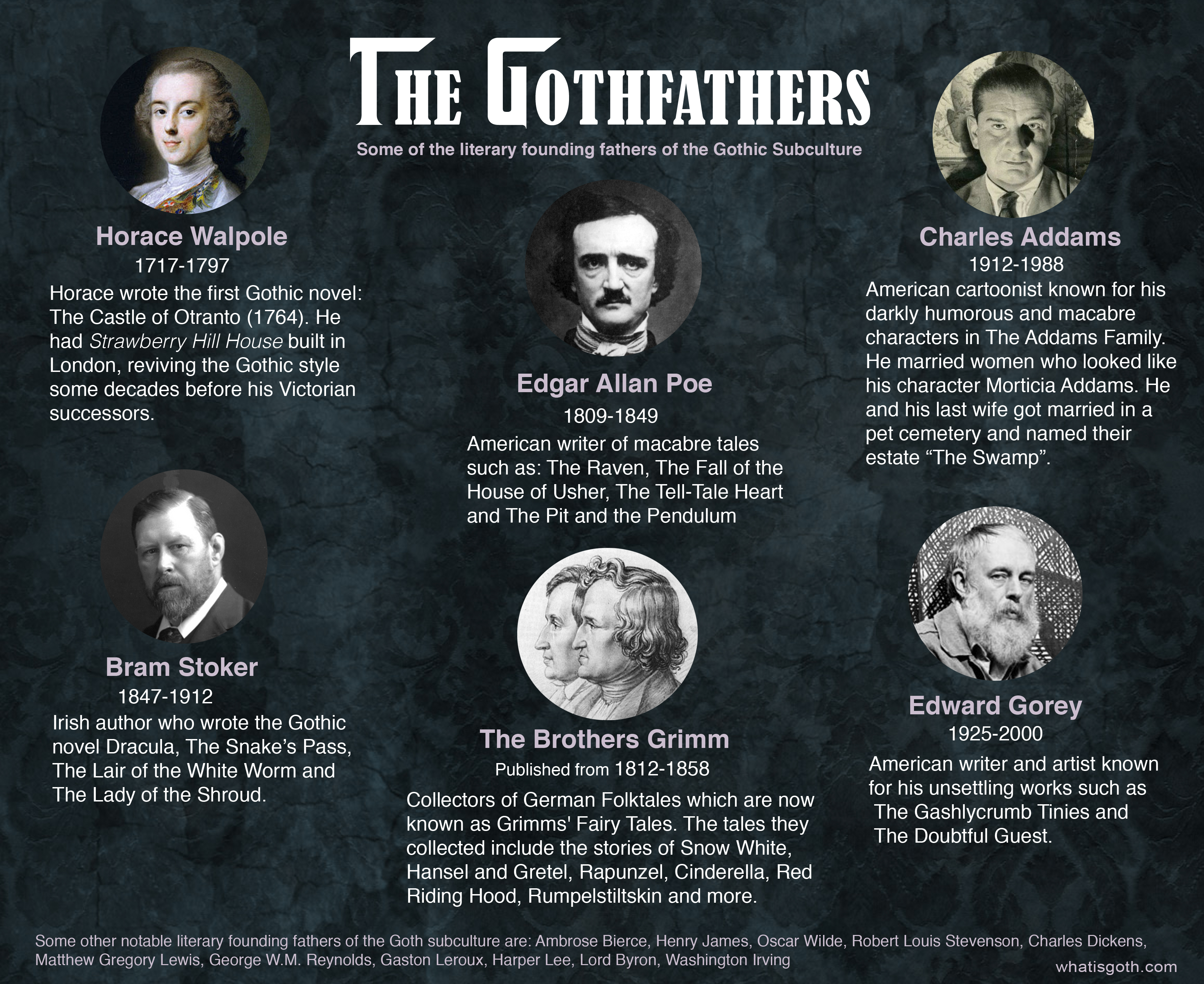
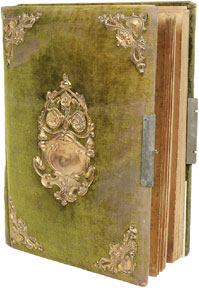
The goth subculture came from aesthetics and philosophies and literary traditions reaching out, linking together in a cumulative genealogy, a goth snowball – changing constantly right up to the present day. At face value, a link between Edgar Allen Poe and Industrial dance music is not one made easily.-Valerie Siebert
The recipe for Gothic literature is a dash of romance, a sprig of the supernatural and a pinch of horror. It is said that the first batch of Gothic literature to ever be served up was by Horace Walpole, with his 1764 novel The Castle of Otranto. But it could be argued that there are earlier works such as Dante's The Inferno which was written sometime during the 1300s.
Gothic literature is intimately associated with the Gothic Revival architecture of the same era. In a way similar to the gothic revivalists' rejection of the clarity and rationalism of the neoclassical style of the Enlightened Establishment, the literary Gothic embodies an appreciation of the joys of extreme emotion, the thrills of fearfulness and awe inherent in the sublime, and a quest for atmosphere. The ruins of gothic buildings gave rise to multiple linked emotions by representing the inevitable decay and collapse of human creations—thus the urge to add fake ruins as eyecatchers in English landscape parks.
Prominent features of Gothic fiction include terror (both psychological and physical), mystery, the supernatural, ghosts, haunted houses and Gothic architecture, castles, darkness, death, decay, doubles, madness, secrets and hereditary curses.
The stock characters of Gothic fiction include tyrants, villains, bandits, maniacs, Byronic heroes, persecuted maidens, femmes fatales, monks, nuns, madwomen, magicians, vampires, werewolves, monsters, demons, angels, fallen angels, revenants, ghosts, perambulating skeletons, the Wandering Jew and the Devil himself.
This literary genre found its most natural settings in the very tall buildings of the Gothic style — often spelled "Gothick", to highlight their "medievalness" - castles, mansions, and monasteries, often remote, crumbling, and ruined. It was a fascination with this architecture and its related art, poetry (such as graveyard poets), and even landscape gardening that inspired the first wave of gothic novelists. For example, Horace Walpole, whose The Castle of Otranto (1764) is often regarded as the first true gothic romance, was obsessed with medieval gothic architecture, and built his own house, Strawberry Hill, in that form, sparking a fashion for gothic revival (Punter, 2004; 177).
Southern Gothic Fiction
Southern Gothic is like its parent genre in that it relies on supernatural, ironic, or unusual events to guide the plot. It is unlike its parent genre in that it uses these tools not solely for the sake of suspense, but to explore social issues and reveal the cultural character of the American South.
Some notable Southern Gothic works that became movies are: The Skeleton Key, Midnight in the Garden of Good and Evil, Angel Heart, To Kill a Mockingbird and Big Fish. This has also exented to music and TV shows. For a full list see Wikipedia's Southern Gothic page.
Suburban Gothic Fiction
Suburban Gothic is dark and disturbing, often employing psychological and supernatural devices to drive the plot along. It uses these devices not so much to entertain, but to explore social issues and to challenge the suburban dream.
Suburban Gothic strives to break down the facade of normality that pervades suburbia. The knights and heroes of traditional Gothic literature have been replaced in most cases by a heroic underdog figure. The grotesqueness of its characters lay not in the dis-figuration of the body but of the mind, delving into the dark and twisted psyche of its characters.
In most cases in Suburban Gothic literature, good does not prevail. Wrongs are often left unrighted and often can not be righted. They are, in fact, often compounded when confronted.
Some notable Suburban Gothic works that became movies are: Heavenly Creatures, Donnie Darko, Edward Scissorhands, Heathers, Lemony Snicket's A Series of Unfortunate Events, The Stepford Wives and Carrie. For a full list of movies, TV shows and books see Wikipedia's Suburban Gothic page.
Gothic Literature Links:
- A List of the Best Gothic Books Of All Time
- Gothic Fiction on Wikipedia
- Wikipedia article on Suburban Gothic Fiction
- Wikipedia article on Southern Gothic Fiction
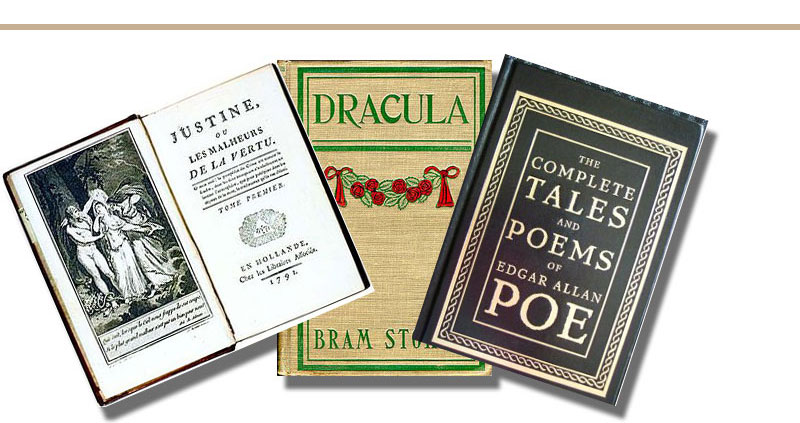

Below is a list of authors of classic Gothic literature and some of their works.
Horace Walpole
The Castle of Otranto (1764), The Mysterious Mother (1768)Ann Radcliffe
The Mysteries of Udolpho, The Castles of Athlin and Dunbayne (1789), A Sicilian Romance (1790), The Romance of the Forest (1791), The Italian (1797)The Brothers Grimm
They are among the best-known story tellers of folk tales from Europe, and their work popularized such tales as Rumpelstiltskin, Snow White, Rapunzel, Cinderella, Hansel and Gretel and The Frog Prince.Bram Stoker
Dracula (1897), The Snake's Pass (1890), The Lady of the Shroud (1909), The Lair of the White Worm (1911)Mary Shelley
FrankensteinEdgar Allan Poe
The Fall of the House of Usher, The Tell-Tale Heart, The Pit and the Pendulum, The Raven, The Haunted Palace, Lenore, A Dream Within a Dream, The Conqueror Worm, To HelenMarquis de Sade
Justine (1791), Juliette, The Misfortunes of Virtue, Eugenie de Franval. The movie Quills is about him.Charlotte Brontë
Jane Eyre (1847), Villette (1853), Shirley (1849), Emma, The ProfessorDante
The Inferno (1300s)Washington Irving
The Legend of Sleepy Hollow (1820)Emily Brontë
Wuthering HeightsJane Austen
Northanger Abbey (1817). The movie Becoming Jane is about her.Oscar Wilde
The Picture of Dorian Gray (1890)Robert Louis Stevenson
Strange Case of Dr Jekyll and Mr Hyde (1886)Charles Dickens
Great Expectations (1860), Bleak House (1852), A Christmas Carol (1843), Little Dorrit (1855)Daphne du Maurier
Rebecca (1938), Jamaica Inn (1936), The Birds, Don't Look NowAmbrose Bierce
The Death of Halpin Frayser (1891), An Occurrence at Owl Creek Bridge, The Devil's Dictionary (1911), The Monk and the Hangman's Daughter (1892), Black Beetles in Amber (1892), Cobwebs from an Empty Skull (1874) and many moreCharles Robert Maturin
Melmoth the Wanderer (1820), Leixlip Castle (1825), The Fatal Revenge; or, the Family of Montorio (1807)- The House of the Seven Gables (1851), Edward Randolph's Portrait (1838), The Scarlet Letter (1850)
Gaston Leroux
The Phantom of the Opera (1911)Percy Bysshe Shelley
Zastrozzi (1810), St. Irvyne (1811), The Assassins (1814), The Coliseum (1817), The Mass (1817)Victor Hugo
The Hunchback of Notre Dame (1831), Les Misérables (1862)
Nathaniel Hawthorne
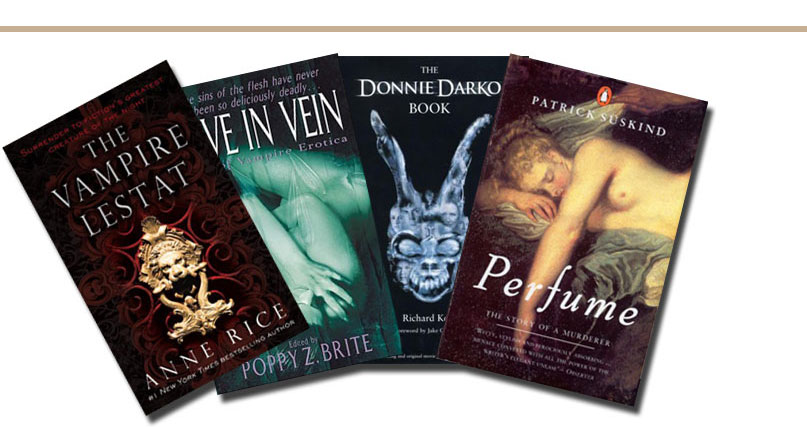

Patrick Süskind
Perfume: The Story of a Murderer (This became a movie), The Pigeon (This story resembles Edgar Allan Poe's "The Raven"), The Story of Mr SommerAnne Rice
Interview with the Vampire, The Vampire Lestat, Queen of the Damned, The Tale of the Body Thief, Mayfair WitchesPoppy Z. Brite
Lost Souls (1992), Drawing Blood (1993), Exquisite Corpse (1996), The Value of X (2002), Liquor (2004)H.P. Lovecraft
The Call of Cthulhu, The Shadow Out of Time, At the Mountains of MadnessH.G. Wells
The Island of Dr. MoreauRichard Kelly
Donnie DarkoJean Rhys
Her novel the Wide Sargasso Sea (1966) was written as a "prequel" to Charlotte Brontë's Jane Eyre and became a movie.Shirley Jackson
The Haunting of Hill House (1959), We Have Always Lived in the Castle (1962), The Lottery (1948). She has influenced such writers as Neil Gaiman, Stephen King, Nigel Kneale and Richard Matheson.- The Gashlycrumb Tinies, The Doubtful Guest (1957) and many more (over 100 books)
- Lemony Snicket's A Series of Unfortunate Events
Edward Gorey
Daniel Handler aka Lemony Snicket
Gothic Books for Kinder Bats (Young Gothlings):
Edward Gorey
The Gashlycrumb Tinies, The Doubtful Guest (1957) and many more (over 100 books)- The Lorax, The Cat in the Hat, Green Eggs and Ham, One Fish Two Fish Red Fish Blue Fish, Hooray for Diffendoofer Day, Oh, The Places You'll Go, How the Grinch Stole Christmas, Horton Hears a Who
- Lemony Snicket's A Series of Unfortunate Events
Dr. Seuss (1904-1991)
Daniel Handler aka Lemony Snicket
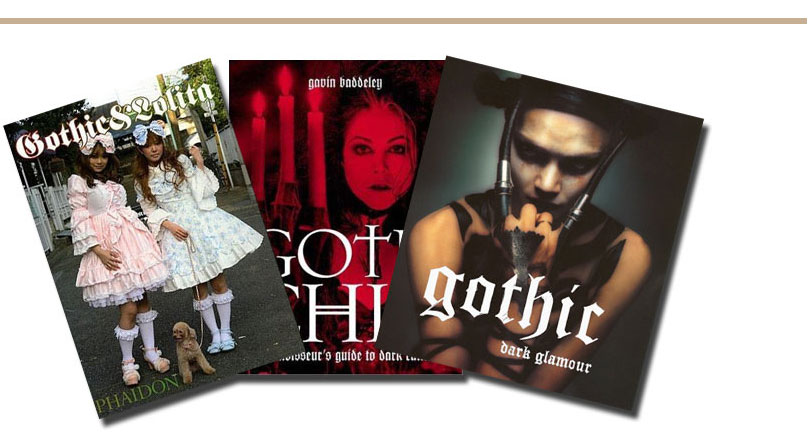

- Gothic: Dark Glamour
- Goth Chic: A Connoisseur's Guide to Dark Culture
- Goth: Identity, Style and Subculture (Dress, Body, Culture Series)
- Hex Files: The Goth Bible
- The goth Bible: A Compendium for the Darkly Inclined
- Gothic and Lolita
- Goth: Undead Subculture
- Gothic & Lolita Bible Volume 1
- Paint It Black: A Guide To Gothic Homemaking
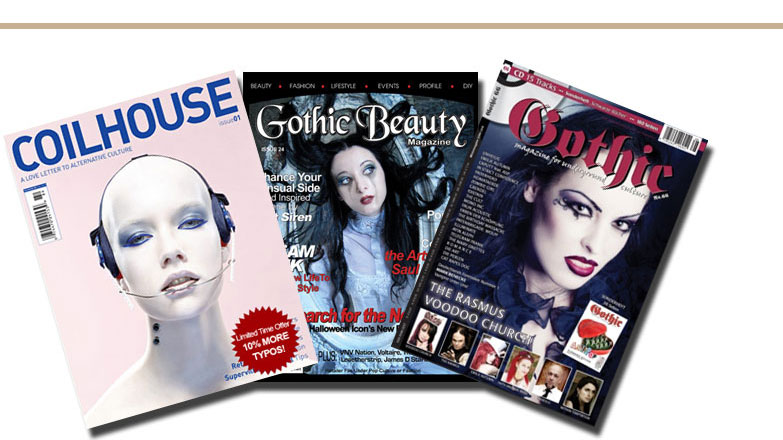

- Coilhouse
- Gothic Beauty
- Auxiliary Magazine
- Steampunk Magazine
- Steampunk Tribune
- Permission Magazine
- Gothic (German Magazine)
- Newgrave Magazine
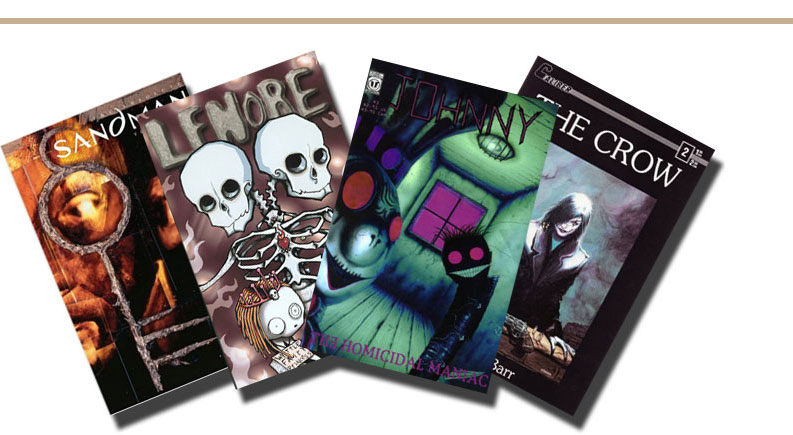

- Jhonen Vasquez Products on Slave Labor Graphics
- Jhonen Vasquez's Question Sleep Website
- Roman Dirge's Spookyland Website
- Roman Dirge Products on Darkhorse
- Things from Another World (comics, Goth stationary, Tim Burton Toys and more)
- List of Gothic Comics
- Neil Gaiman's Website

